Jamaan M. Al-Zahrani1*, Khaled K. Aldossari1, Imad Abdulmajeed2, Sameer H. Al-Ghamdi1,Abdullah M. Al-Shamrani1and Nawaf S. Al-Qahtani1
1College of Medicine, Prince Sattam Bin Abdulaziz University, Alkharj, Saudi Arabia
2Community Medicine, King Abdulaziz Medical City, National Guard Health Affairs, Riyadh, Saudi Arabia
- Corresponding Author:
- Dr. Jamaan M. Al-Zahrani
Assistant Professor, Family and Community Medicine Department
College of Medicine, Prince Sattam Bin Abdulaziz University
Alkharj, Kingdom of Saudi Arabia
Tel: 00966(11)5886135
Fax: 00966(11)5886101
E-mail: jzhrani@gmail.com
Received Date: 07.02.2016; Accepted Date: 25.04.2016; Published Date: 05.05.2016
Keywords
Daytime sleepiness; Epworth scale; Academic performance
Introduction
Sleep is considered an essential factor for good memory, enhanced learning process and mood stability [1]. It has been observed that sleep deprivation among students can lead to psychological dysfunction and adversely affect their academic performance [1-4]. Furthermore, insufficient sleep hours at night can substantially influence general health and quality of life [5]. In particular, insufficient sleep and daytime sleepiness among medical staff are associated with increased risk of road traffic and workplace accidents as well as medical errors [6-8]. Daytime sleepiness among medical students were attributed to irregular bedtime, early waking up and excessive intake of caffeine products and stimulants [9].
Obesity was also significantly factor related to excessive daytime sleepiness [10]. Most students reported insufficient sleep at night, and almost 70% of them reported sleeping less than 8 hours [11]. Students more often than not neglect that poor sleeping habits may affect their educational performance [12]. Daniel et al. observed that reduced family supervision, exposure to new environment and difficulties encountered during study can lead to irregular sleep patterns and hence, sleep deprivation [13].
Studies done in the Kingdom of Saudi Arabia found that the prevalence of stress among medical students, regardless of the academic level, was 63.8%. This high levels of stress may have a negative effect on cognitive functioning and learning of students in a medical school [14]. To cope with stress, most medical students compensate by excessive daytime sleepiness, with most of them having moderate to high level of sleepiness [15]. This rate of daytime sleepiness worsens as medical students progress through their academic life, translating to poor academic performance during examinations [16].
While it is known that many factors can negatively affect the academic performance of medical students like decreased nocturnal sleep time, late bedtimes during weekdays and week-end and increased daytime sleepiness [17]. Furthermore, these factors remain underinvestigated in KSA and there are limited studies which failed to find significant associations between daytime sleepiness, psychological stress and academic performance among medical students. This study aims to fill this gap.
Materials and Methods
Patients and questionnaire
This cross-sectional survey was conducted at Prince Sattam Bin Abdulaziz University Main Campus in Al-Kharj, KSA. The study was conducted during November 2013. All medical students from the second to the sixth year were invited in this study. A total of 161 students agreed to take part. Ethical approval was obtained from the College of Medicine Ethics Committee of the University. Group leaders from all levels facilitated in the data collection. The questionnaire was generated to measure daytime sleepiness. It included items based on previously published survey and international validated scales. It consists of three parts. The first part consists of demographics, academic performance (GPA score), sleep pattern, caffeine intake, smoking habits and time allocated for daily activities and habits. In the second part; adapted validated scales were used with permission which includes the Epworth-sleepiness scale (ESS) to assess daytime sleepiness [18]. This scale targets the students’ tendency to fall asleep in 8 different situations and was scored accordingly (0 = never doze, 1 = slight chance of dozing, 2 = moderate chance of dozing, 3 = high chance of dozing). A cumulative number of all items produces a score between 0-24, and respondents scoring > 10 were considered to have excessive daytime sleepiness. A validated Arabic copy for ESS was also used in order to make the scale easier to understand for the students. Those whose scores were > 3 were considered high scorers (have psychological distress) [19]. A pilot study of 15 students were randomly selected to test the study questionnaire, estimate time needed for study and to identify difficulties in comprehending the questionnaire before conducting the main study.
Data analysis
Data were analyzed using SPSS version 20.0 (SPSS Inc., Chicago, IL, USA). Categorical variables were expressed as frequencies and percentages. Continuous variables were expressed as the mean ± standard deviation (SD). Chi-square test was used to compare frequencies between groups. Significance was set at p-value < 0.05.
Results
The general characteristics were presented in Table 1. The total sample size was N=161 and the response rate was 98%. All participants were males. More than half (52.8%) of the participants were in pre-clinical years (second and third years), majority are single and around 57.5% of them are in Al-Kharj during week days. Approximately 52% of the participants have a GPA score of ≥ 4.5. Only 16.8% of the participants were smokers. Regular caffeine consumption was 95.7%. Most common beverages consumed were tea and coffee (57.1% and 70.2% respectively). Most of study participants were doing regular exercise less than 3 times during week days, while only 7.5% have part time job after college. Table 2 showed the different variables in relation to ESS status. Around 45% in the pre-clinical years and 38.8% of clinical years had excessive daytime sleepiness. No significant differences were elicited in all variables compared.
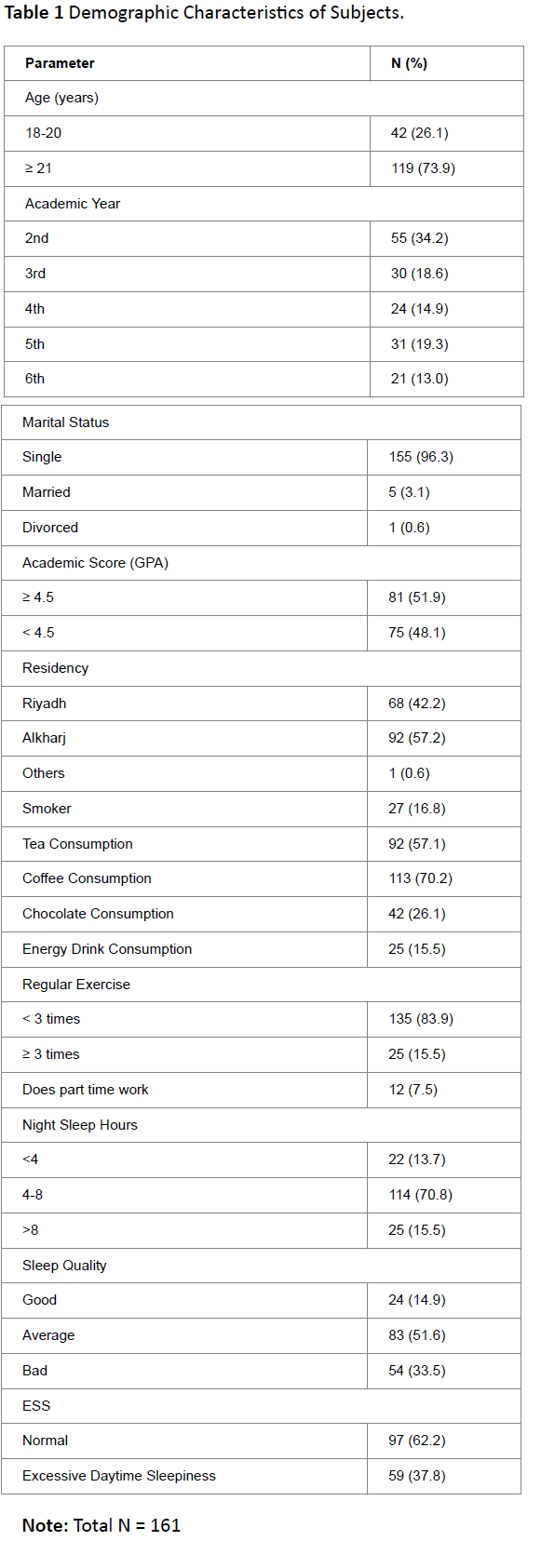
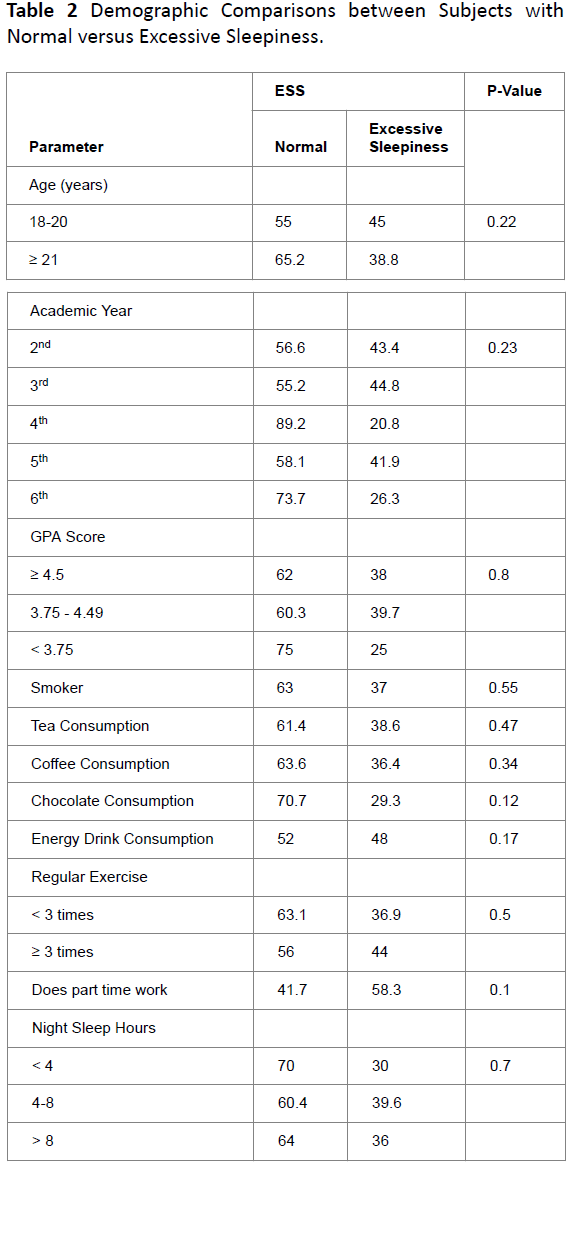
Most medical students (70.8%) had night sleeping between 4-8 hours during the study days. Using the Epworth Sleepiness Scale (ESS) in this study showed that 59 out of 161 participants had excessive daytime sleepiness while 97 were normal (Figures 1 and 2). Figure 3 shows the distribution of subjects with normal and excessive daytime sleepiness according to year level.
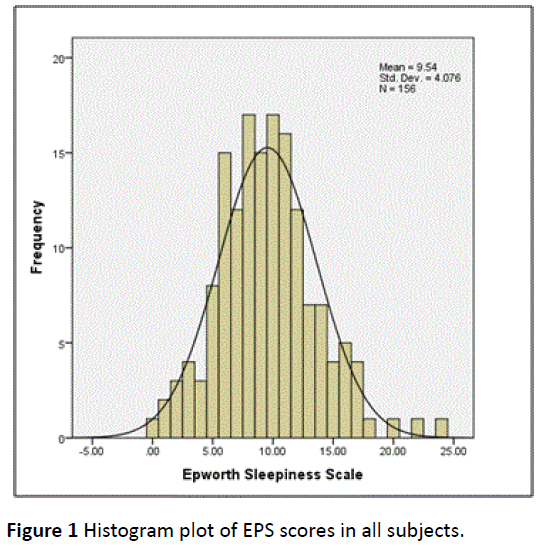
Figure 1: Histogram plot of EPS scores in all subjects.
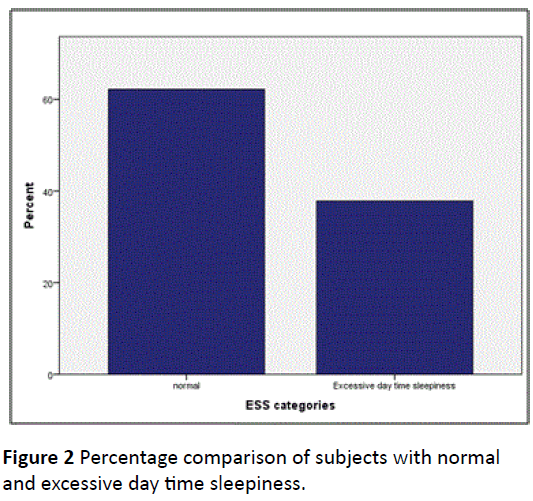
Figure 2: Percentage comparison of subjects with normal and excessive day time sleepiness.
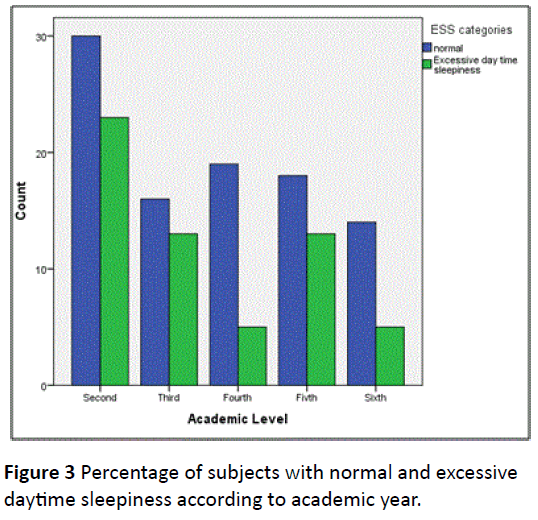
Figure 3: Percentage of subjects with normal and excessive daytime sleepiness according to academic year.
Discussion
The present study aimed to examine the prevalence of daytime sleepiness among medical students and to explore the relationship between daytime sleepiness and academic performance. The prevalence of excessive daytime sleepiness was 37.8% and this does not seem to affect the academic performance of the cohort. The reported prevalence is in comparison with studies done in Pakistan (39.5%) and Malaysia (35.5%) [20,21], but well below the medical students in Brazil (63%) [22].
While no significant difference was elicited in the academic performance of those having normal sleep versus those with excessive daytime sleepiness, it is worthy to note that medical students in KSA, and students in general, are already exposed to academic stress during their earlier school years. This early exposure to stress has been documented in several local studies, indicating high levels of perceived stress among Saudi students entering universities [23,24]. Furthermore, excessive daytime sleepiness and extreme sleep schedules among young Saudis are highly prevalent [25]. In fact, these local observations have been tied more to cardiometabolic disturbances [24]. Given that chronic stress may affect sleeping patterns, most recent studies more concretely associate disturbed sleep patterns with depression and neurobehavioral disorders, rather than academic performance [26,27].
The authors acknowledge several limitations. While ESS questionnaires have been used to assess sleep quality and ESS in most studies, its value in terms of multi-dimensionality casted doubts on its clinical usefulness [28]. Furthermore, the sample size may not be large enough for the findings to be generalized. At best, the present findings are suggestive and further studies are needed to confirm whether or not excessive daytime sleepiness affect academic performance among Saudi medical students.
In conclusion, there is a high prevalence of excessive day time sleepiness among medical students in Alkharj, Saudi Arabia. This disturbed sleep pattern is not associated with academic performance. Longitudinal investigations are warranted to determine whether prolonged sleep disturbances eventually influence the academic performance of this cohort.
Declaration of interest
The authors have no competing interests to declare. The authors have no financial and non-financial conflicts of interest.
9502
References
- Diekelmann S, Born J (2010) The memory function of sleep. Nat Rev Neurosci 11: 114-126.
- Curcio G, Ferrara M, De Gennaro L (2006) Sleep loss, learning capacity and academic performance. Sleep Med Rev 10: 323-337.
- Aldabal L, Bahammam AS (2011) Metabolic, endocrine, and immune consequences of sleep deprivation. Open Respir Med J 5: 31-43.
- Veldi M, Aluoja A, Vasar V (2005) Sleep quality and more common sleep-related problems in medical students. Sleep Med 6: 269-275.
- Assaad S, Costanian C, Haddad G, Tannous F (2014) Sleep patterns and disorders among university students in Lebanon. J Res Health Sci 14: 198-204.
- Howard SK, Gaba DM, Rosekind MR, Zarcone VP (2002) The risks and implications of excessive daytime sleepiness in resident physicians. Acad Med 77: 1019-1025.
- Owens JA (2001) Sleep loss and fatigue in medical training. CurrOpinPulm Med 7: 411-418.
- Melamed S, Oksenberg A (2002) Excessive daytime sleepiness and risk of occupational injuries in non-shift daytime workers. Sleep 25: 315-322.
- Hershner SD, Chervin RD (2014) Causes and consequences of sleepiness among college students. Nat Sci Sleep 6: 73-84.
- Slater G, Pengo MF, KoskyCSteier J (2013) Obesity as an independent predictor of subjective excessive daytime sleepiness. Respir Med107: 305-309.
- Lund HG, Reider BD, Whiting AB, Prichard JR (2010) Sleep patterns and predictors of disturbed sleep in a large population of college students. J Adolesc Health 46: 124-132.
- PilcherJJ, Walters AS (1997) How sleep deprivation affects psychological variables related to college students' cognitive performance.J Am Coll Health 46: 121-126.
- Taylor DJ,Bramoweth AD (2010) Patterns and consequences of inadequate sleep in college students: substance use and motor vehicle accidents.J Adolesc Health 46: 610-612.
- Abdulghani HM, Alrowais NA, Bin-Saad NS, Al-Subaie NM, Haji AM, et al. (2012) Sleep disorder among medical students: relationship to their academic performance. Medical Teacher. 34: S37-S41.
- Zailinawati AH, Teng CL, Chung YC, Teow TL, Lee PN, et al. (2009) Daytime sleepiness and sleep quality among Malaysian medical students.Med J Malaysia 64: 108-110.
- Rodrigues RN, Viegas CA, Abreu E Silva AA, Tavares P (2002) Daytime sleepiness and academic performance in medical students. ArqNeuropsiquiatr 60: 6-11.
- Bahammam AS, Alaseem AM, Alzakri AA, Almeneessier AS, Sharif MM (2012) The relationship between sleep and wake habits and academic performance in medical students: a cross-sectional study. BMC Med Educ 12: 61.
- Johns MW (1994) Sleepiness in different situations measured by the Epworth Sleepiness Scale. Sleep 17: 703-710.
- Goldberg DP, Gater R, Sartorius N, Ustun TB, Piccinelli M, et al. (1997) The validity of two versions of the GHQ in the WHO study of mental illness in general health care.Psychol Med 27: 191-197.
- Surani AA, Zahid S, Surani A, Ali S, Mubeen M, et al. (2015) Sleep quality among medical students of Karachi, Pakistan. J Pak Med Assoc 65: 380-382.
- Zailinawati AH, Teng CL, Ching YC, Teow TL, Lee PN, et al. (2010) Daytime sleepiness and sleep quality among Malaysian medical students. Med J Malaysia 64: 108-110.
- Pagnin D, De Queiroz V, Carvalho YT, Dutra AS, AmaralMB et al. (2014) The relation between burnout and sleep disorders in medical students.Acad Psychiatry 38: 438-444.
- Al-Daghri NM, Al-Othman A, Albanyan A, Al-Attas OS, Alokail MS, et al.(2014) Perceived stress among Saudi students entering universities: a prospective study during the first year of university life.Int J Environ Res Publ Health 11: 3972-3981.
- Al-Daghri NM, Al-Othman A, Al-Attas OS, Alkharfy KM, Alokail MS, et al. (2014) Stress and cardiometabolic manifestations among Saudi students entering universities: a cross-sectional observational study. BMC Public Health, 14: 391.
- Merdad RA, Merdad LA, Nassif RA, El-Derwi D, Wali SO (2014) Sleep habits in adolescents of Saudi Arabia; distinct patterns and extreme sleep schedules. Sleep Med 15: 1370-1378.
- Chen TY, Chou YC, Tzeng NS, Chang HA, Kuo SC, et al. (2015) Effects of a selective educational system on fatigue sleep problems, daytime sleepiness, and depression among senior high school adolescents in Taiwan.Neuropsychiatr Dis Treat 11:741-750.
- Kang JH, Chen SC (2009) Effects of an irregular bedtime schedule on sleep quality, daytime sleepiness, and fatigue among university students in Taiwan. BMC Public Health 9: 248.
- Gelaye B, Lohsoonthorn V, Lertmeharit S, Pensuksan WC, Sanchez SE, et al. (2014) Construct validity and factor structure of the Pittsburgh sleep quality index and epworth sleepiness scale in a multi-national study of African, South East Asian and South American college students.PLoS One9: 116383.










